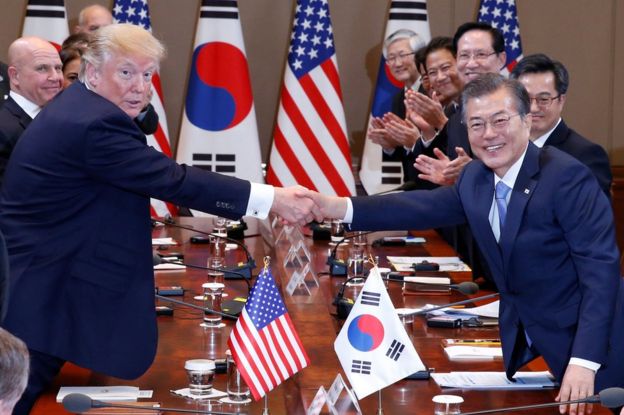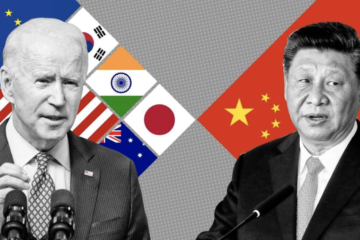In 1977, at the height of the Cold War, Lucasfilm released Star Wars, the beginnings of a saga centred around totalitarianism, imperialism and planetary destruction. Just a few months earlier, for the third time in history, the US Joint Chiefs of Staff declared DEFCON 3 in South Korea, as a result of the so-called “Axe Murder Incident”. On 18 August 1976, two officers, Arthur Bonifas and Mark Barrett, had been murdered by North Korean soldiers in the Korean Demilitarised Zone for cutting down a tree which was allegedly planted by Kim Il-Sung. A handful of years later, in 1983, President Reagan announced a missile defence system which aimed to protect the US from nuclear warfare. The Strategic Defense Initiative, or as it was more popularly known “Star Wars”, was ultimately curtailed due to fears that destabilising the prevailing Mutually Assured Destruction (MAD) framework would reignite an arms race amongst the world’s superpowers. Due to these fears, and the reduction of nuclear arsenals following the end of the Cold War, support for “Star Wars” faltered. Yet, in recent years nuclear tensions have re-emerged, not least in North Korea, and perhaps it is fitting that both the film series and anti-nuclear defence initiatives have seen a resurgence of late. Though rather more grounded, the introduction of the Terminal High Altitude Area Defense (THAAD) system to South Korea has faced similar criticisms. Although the US and South Korea insist that the system is purely a counter-measure against the North Korean threat, Chinese officials have argued that such a system could limit Chinese nuclear capabilities, once again unbalancing the MAD system.
There have been various criticisms of the system from China: that the powerful radar used by THAAD could be used to track targets within China, and that the system would be ineffective against North Korean missiles because of its proximity, suggesting it is actually aimed at China, yet these claims have little basis in fact. There are already two THAAD radars in Japan which, while perhaps less deeply, already penetrate into China. In its current state THAAD is incapable of destroying missiles in their boost or mid-course phase, and can only destroy short-range missiles during the terminal phase, meaning it is highly unlikely to affect China’s ability to target the US, as missiles would only enter their terminal phase thousands of miles from the Korean peninsula. The US has said that it has offered numerous technical briefings on the system, yet Chinese officials have been disinclined to take them up on the offer. Consequently, many analysts have suggested that opposition to THAAD is primarily a political tool, one aimed at dividing South Korea and its American allies. Mid-course: majority of the time of flight of a missile when adjustments are made Terminal: final portion of the flight when payload begins to reenter the atmosphere towards targetBallistic missile flight phases
Yet since the THAAD debacle relations have notably cooled. Though it did not impose official sanctions, the Chinese government strongly protested the agreement by the Park administration to deploy the system in July 2016. Upon the arrival of the first missiles and radar systems in March 2017, China mobilised a common tool in its arsenal, popular nationalism. Official media channels urged citizens to express their dissatisfaction with Korea, and widespread boycotts of Korean goods began, with many being removed from shops. Indeed, the government went as far as banning package tours of South Korea from March onwards. One particular focus of Chinese wrath has been the Lotte group, which had agreed to allow the deployment of THAAD on its property, a golf course in Seongju.
Certainly, the deployment of THAAD has not taken place without significant resistance within South Korea. The “Candlelight Protests” have been underway for almost a year now, with residents of Soseong-ri, the village nearest to where THAAD is deployed, holding nightly vigils outside the Seongju County office. Since the deployment there in April, there have been thousands of police officers positioned in the area, and on 7 September a confrontation between 600 protesters and 8000 police saw 38 people injured.

While there had been hopes, both from these protesters and the Chinese, that South Korea’s new President, Moon Jae In, would be more amenable to blocking the deployment of THAAD, increasingly aggressive North Korean launches since late July have seen Moon change his tune somewhat, and agree to limited deployment. During the 2017 presidential campaign that followed the impeachment of Park Geun-Hye, Moon positioned himself as a strident critique of THAAD deployment, criticising the decision as unilateral and undemocratic, and calling for increased dialogue with North Korea. Though he has since begun acting contrary to Chinese interests, Moon has nonetheless been seen in a more favourable light than his predecessor. This is perhaps due to his previous opposition, his insistence that these are temporary measures and his more “proactive” approach to the matter. Unlike his predecessor, Moon has insisted that the deployment of four launchers thus far is only temporary, and his Foreign Minister, Kang Kyung-wha, announced two weeks ago that South Korea would not seek further deployments. These steps have been much lauded in the Chinese state-press, with the Global Times praising “a new gesture that is welcomed”. Indeed, following a joint statement issued two weeks ago by the South Korean and Chinese foreign ministries, urging cooperation, China has signalled that it will dismantle its unofficial sanctions. Yet, China still claims to be nursing some wounds, and has cast doubts upon the extent of possible rapprochement. Shortly after that announcement, an unnamed Chinese official stated that this was ‘just the beginning’ and that ‘[he] didn’t think relations can ever go back to their pre-THAAD era’.
Certainly it may seem difficult to discern the meaning of all this, of the true purpose of THAAD, of the varied changes in Chinese attitudes towards South-Korea, and of the strategic goals of their protestations. Though there is some debate about the relative efficacy of THAAD against Chinese and North-Korea nuclear warfare, the consensus is largely that the system would be almost wholly ineffective against Chinese threats and mostly effective against North Korean ones. Consequently, as a US imposition, and something which divides South Korean politics, the varied Chinese machinations regarding THAAD seem primarily aimed at fomenting anti-American protest, and forcing South Korean dialogue and compromise with China. To an extent these measures seem to be working, Moon is undoubtedly far more favourable to the Chinese than his predecessor, and he was elected partially due to an anti-THAAD (and therefore anti-US) position. South Korea is a key US ally in the region, with almost 30,000 US troops posted there in fifteen bases. Yet, on Sunday protests erupted over the upcoming Trump visit, with as many as 5,000 rallying in Seoul. Interestingly, there was another protest taking place at the same time, just a few streets away. This protest was, an admittedly smaller, one, there to welcome Trump and call for military interventionism. Today has witnessed similar protests, and over 15,000 police have been deployed to safeguard the Trump visit. Perhaps this is what China intended all along, a divided Korea is one open to Chinese influence, to negotiation, intimidation and compromise. In that light, the entire THAAD dispute seems to be something of a straw man, and President Moon is beginning to blow, just gently, in the wind.


